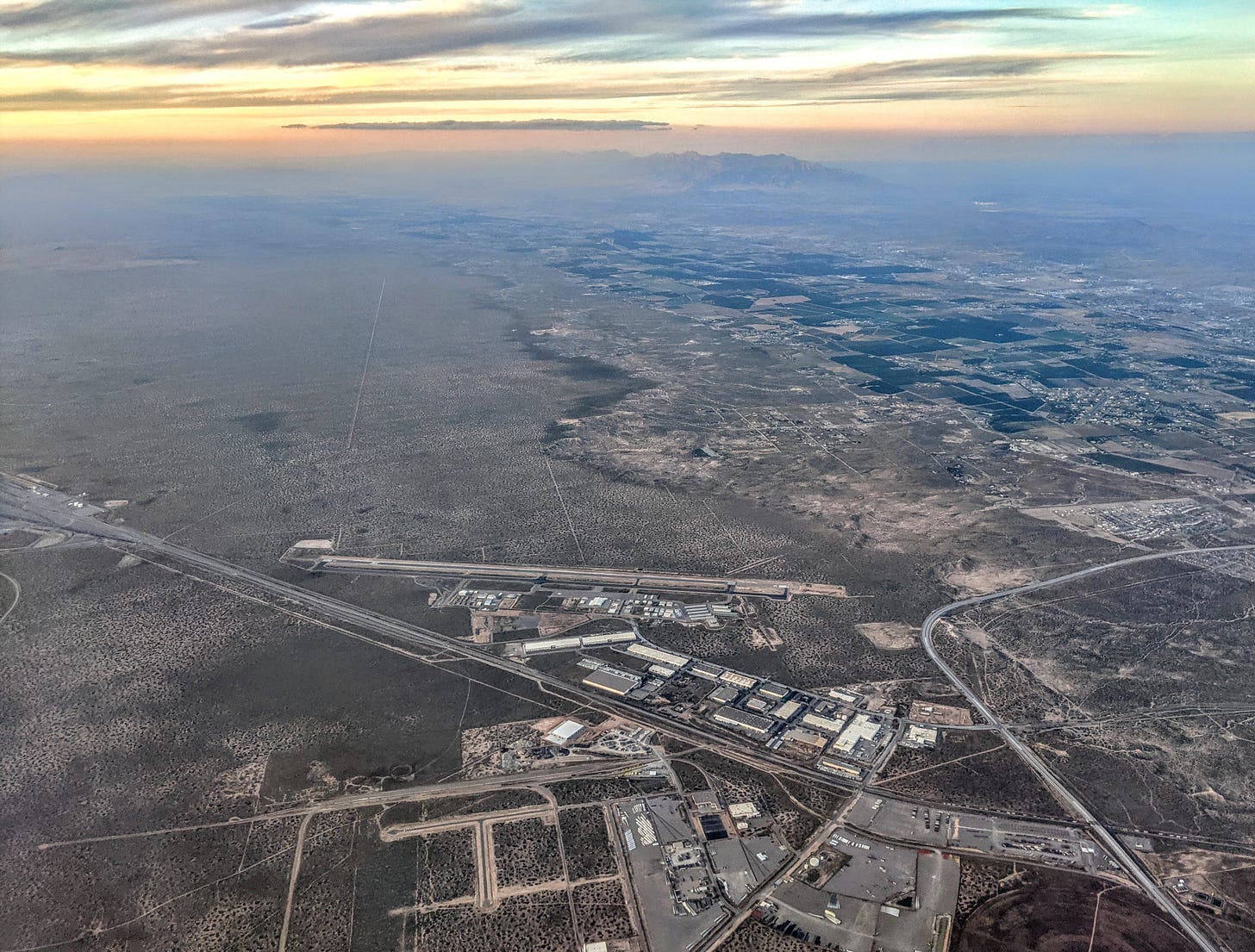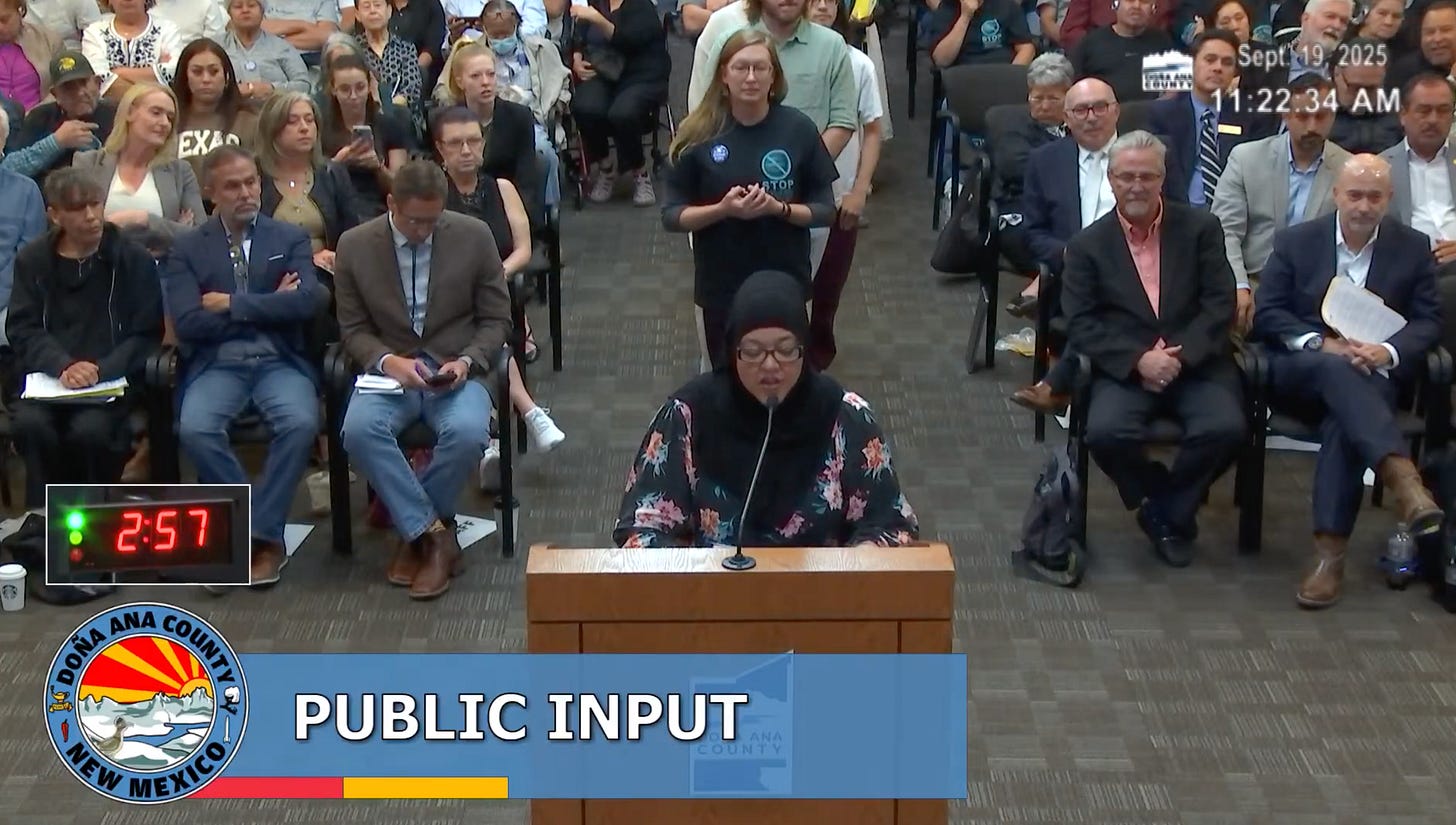As AI Data Centers Target the Water-Scarce Borderlands, New Mexico Invests in Desalination
Meanwhile, community members worry about stealth approval processes and a lack of transparency.

New Mexico will soon host a massive new data center backed by Oracle and OpenAI. Known as Project Jupiter, it was approved September 19 by the Doña Ana Board of County Commissioners in a 4–1 vote. The “hyperscale” complex will be located just north of the Santa Teresa port of entry, less than 10 miles from El Paso, Texas.
The complex will be part of Project Stargate, the companies’ initiative to build a series of data centers for AI with a combined capacity 10 gigawatts. If Project Jupiter is built to its planned capacity of 700 to 900 megawatts, it would exceed Nevada’s Citadel, currently the highest-capacity data center in the United States.
Locals learned of the $165 billion project just one month before the county approved it. During the debate before the vote, proponents touted the project as a major opportunity for economic development, while opponents raised concerns about its water and energy use, as well as the rushed approval process.
From 2017 to 2024, the number of data centers in the U.S. increased from 318 to 5,208. These complexes are notorious for their high water and energy consumption, and New Mexico’s resources are already strained. So where will the water for Project Jupiter come from?
The answer might lie underground, in a source still untapped by New Mexico: brackish groundwater. While the Doña Ana County commissioners were considering Project Jupiter, they were also reviewing proposals for a desalination plant, in parallel to a new state program incentivizing such infrastructure for economic growth. While this technology could significantly boost the state’s water supply, scientific and legal questions remain—including about the impact of brackish-water extraction on existing water sources, the energy requirements for desalination, and waste management.

The Water Crisis
Water in New Mexico is a pressing concern, especially in Doña Ana County. Water resources statewide are expected to decline by 25 percent in the next 50 years, affecting both surface and groundwater.
Both sources have been strained in Doña Ana for years. The county is home to New Mexico’s second-largest population, and it has over 73,000 acres of irrigated crops like pecans and alfalfa. In 2020, it had the highest water use of any county in the state.
About 40 percent of the water withdrawn in Doña Ana County is surface water from the Rio Grande watershed, primarily used for irrigation, while 60 percent is groundwater, which supplies most communities’ drinking water.
Since 2000, the Rio Grande has flowed with an average of 16 percent less water than it did during the 20th century. As surface waters have diminished, farmers have increasingly pumped groundwater. From 2000 to 2015, well levels fell from 10 feet below the surface to 25 feet.
The county has also struggled with water quality. During the last decade, the Camino Real Regional Utility Authority, which served the border communities of Sunland Park and Santa Teresa, repeatedly exceeded the allowable arsenic threshold in its drinking water. “Yellow water, orange water, arsenic in the water, smelly water,” recalled Daisy Maldonado, director of Empowerment Congress. In May 2025 the county cut ties with the utility and filed a lawsuit seeking arsenic monitoring and penalties.

The Borderlands’ Data Boom
At the same time as southern border communities face decreasing water supplies, data centers are increasing demand for the resource. With the rise of artificial intelligence, the deserts of Maricopa County, Arizona, and West Texas have become hot spots for development due to two key factors: open land and cheap electricity.
Now companies are exploring opportunities in other desert municipalities. In Tucson, Arizona, for instance, summer 2025 saw a heated battle over a data center called Project Blue—projected to have a capacity of up to 700 megawatts—which is advancing despite a no vote from city council members.
In selecting locations for these complexes, large tech companies take advantage of state and local tax benefits: Project Jupiter’s industrial revenue bond frees it from property tax responsibilities, and the project is eligible for a 50 percent rebate on its gross receipts taxes. Data centers in Arizona, meanwhile, pay no sales taxes on the hardware they house—the price tag of which is estimated at $24 billion in Project Blue’s case.
What the desert Southwest lacks, however, is another key ingredient for data centers: water. Data centers use water to cool their servers and routers. Cold water is continuously pumped through the facilities to absorb the servers’ heat, which is released as steam. Large data centers can consume up to 5 million gallons of water a day, and a 2024 report by Lawrence Berkeley National Labs estimates that data centers consumed 17 billion gallons in 2023. According to the report, that number could double or even quadruple by 2028.
The team behind New Mexico’s Project Jupiter claim their data center is different. Its proposed design uses a “closed-loop” cooling system in which the water piped through the facility isn’t released as steam but is air-cooled using natural gas for repeat use. But it will still require an initial fill-up of 10 million gallons over two years; thereafter, it will use 7.5 million gallons a year. And those numbers don’t account for the additional water needed to generate power for its cooling system.
The Desal Bet
At the August 26 Doña Ana County Board of Commissioners meeting, Assistant County Manager Stephen Lopez said desalination could provide the county about 800 years’ worth of water, describing it as “much better than taking from the valley” or “trying to rely on the river.” Later, Lanham Napier, CEO of BorderPlex Digital, the developers of Project Jupiter, said, “There’s a lot of water resource to be developed in the region from that brackish resource. We are happy to support that.” (Lopez did not reply to interview requests from Border Chronicle. BorderPlex Digital declined to provide additional information.)
Doña Ana’s bid for desalination comes on the heels of a major boost of state-level support for desalination. In March the state legislature approved HB137, creating the Strategic Water Supply program, which allocates $40 million for grants to communities to pursue desalination infrastructure.
Desalination plants process high-salinity waters through thousands of reverse-osmosis membranes that remove minerals. This water can come from ocean sources or, in landlocked areas like New Mexico, salty layers in aquifers. Governor Michelle Lujan Grisham has emphasized that this newly available water will facilitate economic growth.
According to Jonas Armstrong, director of the Water Protection Division of the New Mexico Environment Department, experts estimate that up to 650 trillion gallons of brackish groundwater lie beneath New Mexico. In feasibility studies, Armstrong said, the state identified various applications for the treated water, including concrete production, wind turbine and solar panel production, manufacturing processes, and cooling at data centers.
“The basic idea is to conserve fresh water for residential and agricultural use and use the brackish water for manufacturing,” said Drew Goretzka, director of communications for the New Mexico Environment Department.
While this state investment in desalination is new, research on the technology has been ongoing in New Mexico for nearly two decades. In 2007 the United States Bureau of Reclamation established the Brackish Groundwater National Desalination Research Facility in Alamogordo, just east of Doña Ana County. The facility provides wells for university and private-sector researchers to develop new desalination technologies. Although there is not yet a formal affiliation between the federal research center and the state’s Strategic Water Supply program, Armstrong called the Strategic Water Supply program “a way for New Mexico to finally leverage that expertise that is right here in our backyard.”
Globally, there are over 20,000 desalination plants in countries ranging from Australia to Mexico to Saudi Arabia. El Paso, Texas, just across the state line from Doña Ana County, operates the world’s largest inland desalination plant, producing about 5 percent of the city’s water needs. “It’s a technology that has been proven here at the research level and also across the country at the operational level,” said Armstrong. “We know desal works at scale.”

Fault Lines
According to Stacy Timmons, associate director for Hydrogeology Programs at the New Mexico Bureau of Geology, using the state’s brackish groundwater might not be as simple as the county imagines. In parallel to the Strategic Water Supply program, Timmons’s agency has begun mapping all the state’s aquifers, which have never been fully defined.
“In the Santa Teresa area, we have some data, but we haven’t got a firm picture of what the brackish-water potential is,” Timmons said. “People put out estimates, but it’s a whole other ball game if you want to actually pull that water. In some places you physically cannot because of the collapse of aquifer material.” In other places, the state’s complex geology has put the aquifer’s fresh and salty layers close to one another, and once you begin to extract the brackish water, freshwater can seep in, she said.
This is a particular concern near the Rio Grande, which runs through Doña Ana County. New Mexico and Texas have been locked in a yearslong Supreme Court battle over how groundwater pumping in southern New Mexico has affected Texas’s share of water from the Rio Grande. “The flow of the river on the surface is already challenged because of how much drawdown on the adjacent aquifer there has been from irrigation pumping, and [pumping brackish water] could exacerbate that,” said Timmons.
Armstrong said that only Strategic Water Supply programs that show “they are not negatively impacting quantity or quality” will be approved. Malynda Cappelle, facilities manager of the Bureau of Reclamation brackish groundwater research center, said aquifer mapping is crucial for developing desalination infrastructure. “Whether you are a city, community, or industry,” she said, “you need to know where that water is,” along with identifying energy sources and disposal sites for the concentrated salty wastewater.

In the Shadow of Project Jupiter
If New Mexico invests heavily in desalination, more large-scale projects like Project Jupiter are likely to follow. This worries local residents, who say Project Jupiter’s approval process was rushed and filled with oversights, and that county officials lacked the necessary information to make an informed decision.
The public became aware of Project Jupiter only after the August 19 Board of Commissioners meeting. “I don’t think anybody knew that meeting was going to be the release of something that huge,” said Jonathan Delgado, a teacher who helped organize local opposition to the project. Data center developers have acted similarly in other cities, frustrating residents who feel kept in the dark about projects that will have a significant impact on their communities. (In Tucson, for instance, most residents learned of Project Blue only when the Pima County Board of Supervisors voted to approve it in early June.) Delgado added, “There’s no way a $165 billion facility that’s going to be built in six months just got started.”
Local opponents of Project Jupiter said the project’s developers pressured county commissioners to expedite approval despite its unprecedented scale. No environmental impact statement was conducted, and board members signed nondisclosure agreements, withholding key information from the public.
In Tucson, city council members also signed NDAs regarding Project Blue, and community uproar led to stricter rules about their use. “That’s something I’d like to see nationwide,” said Luke Felix-Rose of Tucson, who opposed Project Blue and later allied with New Mexico’s Project Jupiter opponents. “This NDA problem is going to destroy our democracy if we let it.”
Now that Project Jupiter has been approved, activists said they planned to fight to ensure transparency about the project’s progress and to regulate its impact.
“This is not a partisan problem,” said Felix-Rose. “This is a matter of exploitative development coming into our small desert cities and exploiting us for every grain of sand we have.”
This story was supported by The Water Desk.


I keep thinking of a bigger picture of these issues... watched on our library Kanopy streaming, a doc from 2022 called "The Grab"..sobering and insightful, about land and water grabs....then on this end, how wedded are we to things "the cloud", 5G and such are we willing to look at as how we are "demanding'' all what the data centers ''offer"...Seems the centers are set up to use high amounts of water, OR electricity OR both ! Thanks for this info...a great reality check for what we value... most.
Santa Theresa has a great Air Museum.